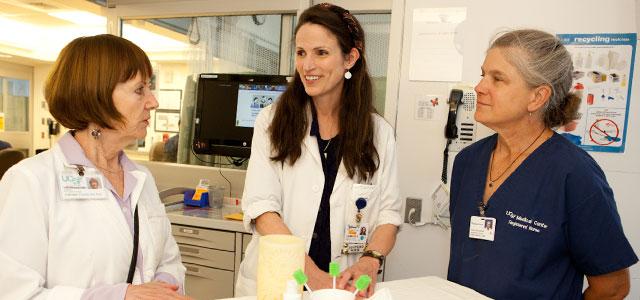
Kathleen Puntillo (left) with colleagues Kathleen Turner and Susan Barbour at UCSF Medical Center (photos by Elisabeth Fall)
UC Health Helps ICU Nurses Bring Palliative Care to Patients
In the six months before we die, more than 15 percent of Americans age 65 and older will spend a week or longer in the intensive care or cardiac care unit. But most of us will not receive the kind of care that studies consistently indicate people want at the end of life: supportive, holistic care that takes into account one’s values, desires and goals and addresses the entire spectrum of health-related needs that a seriously ill person may have.
A new two-year initiative led by UC San Francisco’s Kathleen Puntillo, Wendy Anderson and Steven Pantilat aims to expand access to that kind of care – known as palliative care – in intensive care units across five UC academic health centers, which along with UC’s 18 health professional schools are collectively known as UC Health. Titled IMPACT-ICU: Integrating Multidisciplinary Palliative Care into the ICUs, the project initially aims to help bedside critical care nurses understand how to integrate palliative care into their day-to-day work. The thinking is that while palliative care is a multidisciplinary effort, nurses are the most constant element in a patient’s care and are therefore well suited to becoming leaders in expanding access to this type of care in ICUs.
A New Discipline
Palliative care is a relatively new clinical specialty. The National Board for Certification of Hospice and Palliative Nurses began certifying nurses in 1994, and palliative care was recognized by the American Board of Medical Specialties in 2006. Recognition and certification formalize expertise in aspects of care that go beyond treating a patient’s medical condition to include symptom management, psychosocial support, spiritual care, family care and other elements that affect quality of life.
“It’s trying to address all the dimensions that matter to people,” says Pantilat, director of UCSF’s Palliative Care Service. “Even something like pain isn’t just a physiological phenomenon. It’s got social, psychological and emotional implications, maybe even spiritual implications. You can’t just give morphine for that.”
 That’s why a palliative care team typically includes physicians, nurses, social workers and chaplains – and, at times, pharmacists, dieticians and occupational therapists – to enhance a patient’s quality of life regardless of prognosis.
That’s why a palliative care team typically includes physicians, nurses, social workers and chaplains – and, at times, pharmacists, dieticians and occupational therapists – to enhance a patient’s quality of life regardless of prognosis.
Not all ICU patients need that level of expert palliative care, but most would benefit from honest, compassionate conversations about prognosis, goals of treatment, symptom management and other stressors that affect them and their families. Unfortunately, such conversations don’t always happen, says Puntillo, professor emerita at UC San Francisco School of Nursing. The reasons for that failure, she says, include a fragmented health care system that often doesn’t reward talking with patients, misperceptions about what palliative care means – including confusing it with hospice – and lack of palliative care-specific education for clinicians.
While palliative care has begun to gain a foothold in many settings, IMPACT-ICU aims to advance the effort in a unique way with its focus on training bedside ICU nurses.
Birth of IMPACT-ICU
The project grew out of an End-of-Life Care Committee (now the Palliative Care Committee) that Puntillo and several other nurses and physicians from the UCSF medical-surgical ICU formed about 10 years ago. It was a response to nurses voicing concerns about the care dying patients were and weren’t receiving – and the nurses expressing an interest in getting more education about palliative care.
In response, Puntillo and Anderson, both of whom had taught related communication skills to clinicians, formed an interdisciplinary group that developed a series of workshops. Since 2010, they’ve trained 95 critical care nurses at UCSF Medical Center in palliative care communications. The program has proved so popular that each session has a waiting list within a day of being announced.
Then, last year, the Center for Health Quality and Innovation Quality Enterprise Risk Management – a joint venture of the UC Center for Health Quality and Innovation (CHQI) and the UC Office of Risk Services that provides funding for projects that have the potential to both improve care and reduce risk – put out a request for proposals. Anderson and Puntillo recognized the opportunity to increase patient access to palliative care throughout the UC system by empowering bedside nurses to become more actively engaged in making the important conversations happen.
Terry Leach, executive director of the CHQI, says their proposal was successful because palliative care is good for patients and families, and good communication is one of the pillars of risk reduction. The project received just over $1 million for a two-year rollout that began this summer and continues with workshops for critical care nurses at all five UC medical centers.
Initially, the IMPACT-ICU project is focused on ensuring that bedside nurses have the skills and resources they need to engage in palliative care discussions with families, physicians and other clinicians. Each of the five UC medical centers has identified two ICU sites and two nurse leaders (either nurse practitioners or certified nurse specialists with expertise in palliative care) to implement the program. The nurse leaders attended a three-day training at UCSF that taught them to lead quarterly workshops for other critical care nurses in their medical centers.
The workshops begin by outlining the ICU nurse’s role, rights and responsibilities in discussing prognosis and goals for care with patients and families. “Often, ICU nurses feel like they’re not supposed to participate in those discussions,” says Puntillo. “We give them the background to empower them and to understand that this is part of their nursing practice.”
During the workshops, the nurses also engage in role-playing that helps them practice leading palliative care discussions with families – and facilitating group meetings between nurses, physicians, patients and families.
Another aspect of the workshop focuses on nurses caring for themselves, an often-forgotten component of critical care bedside nursing that can affect quality of care. “These discussions are difficult,” says Janice Noort, a palliative care nurse practitioner and one of the leaders of the IMPACT-ICU project at UC Davis. “[Critical care nurses] are at high risk for burnout and compassion fatigue that comes from working in this life-and-death environment.”
In addition to leading the workshops, the nurse leaders round in the ICUs to provide real-time support to bedside nurses as they’re trying to apply the skills they’ve learned. “[This involves] looking at patients’ symptoms that may be uncontrolled and identifying other patient needs that really haven’t been looked at before,” says Noort.
Reducing Costs by Improving Quality and Meeting Patient Needs
By paying closer attention to patient needs, palliative care has the potential to improve outcomes and reduce costs. Pantilat notes that when a detailed palliative care discussion happens, patients often express a desire for care that is less invasive and more focused on symptom control and quality of life. That kind of care is less costly according to a 2008 study published in the Archives of Internal Medicine, and can free up resources for what patients really want, such as assistance with staying in their homes. Even if only a subset of the estimated 5 million Americans admitted to an ICU annually were to receive palliative care, the savings could be considerable.
That’s partly because the US health care system has evolved to reward more, rather than better, care. Historically, because clinicians have been paid for procedures, not outcomes, Pantilat says aggressive, all-out care tends to be the default, even when patients might not want it and when it’s unlikely to be beneficial. Palliative care providers strive to interrupt that default thinking and step back to find out what’s really important to patients and families.
Both Pantilat and Puntillo stress that this approach is absolutely not about denying any medical care to patients who want and can benefit from it. Unlike hospice, which in the US requires that a patient be within six months of dying and asks patients to forgo aggressive care, palliative care can be given alongside all kinds of care, including curative treatment, and can benefit any patient with a serious, but not necessarily terminal, illness.
As a former practicing nurse and former hospital attorney, Leach has seen the problems that arise when communication about goals and needs doesn’t happen. “When you’ve got a seriously ill patient and their family members, all circuits are firing at a very stressful level,” she says. “When they don’t feel [the specialists] are talking to one another, it can be very frustrating.”
If critical care nurses can have conversations about goals and desires with families of seriously ill patients, it can defuse the situation and lead to happier patients and families. “We see it in patient satisfaction scores,” she says. “When we engage families and patients, we know that their care feels better – and they sue less.”
Why Nurses
As the most consistent hospital presence for both patients and families, the bedside nurse is often the most logical choice to initiate palliative care discussions.
“Family members don’t necessarily have adequate opportunities to communicate with physicians, and one physician may not communicate with another team taking care of the same patient,” says Puntillo. “It can be very disjointed.”
 On the other hand, a typical ICU patient has two primary nurses that work in 12-hour shifts, so they’re with the patient almost constantly and are privy to interactions and conversations that other members of the care team and family members aren’t. “It’s the nurse practicing shuttle diplomacy,” says Puntillo.
On the other hand, a typical ICU patient has two primary nurses that work in 12-hour shifts, so they’re with the patient almost constantly and are privy to interactions and conversations that other members of the care team and family members aren’t. “It’s the nurse practicing shuttle diplomacy,” says Puntillo.
In addition, demand for palliative care services throughout the hospital and beyond is growing, and there aren’t enough palliative care specialists to meet it. Empowering nurses to be more proactive and engaged in discussions about goals of care can potentially change the structure for palliative care in the ICU setting, says Noort.
“There are limitations to the consultative model and a lot of strength to having the main people who are taking care of you [bedside nurses] provide your palliative care,” says Anderson. “What’s unique about [the IMPACT-ICU project] is that it creates a model for providing nurses with palliative care skills and also access to specialist palliative care nurses. At many hospitals, specialist palliative care can only be engaged through physicians. It is very challenging for critical care bedside nurses not to have direct access to palliative care expertise.”
Through the workshops and by placing palliative care nurse leaders directly in the ICU, the project will give bedside nurses both the skills they need and direct access to greater expertise when it’s needed.
Moving the Conversation Forward
Once the first phase of the project is complete, investigators will focus on engaging other ICU clinicians to integrate palliative care into their day-to-day interactions with patients and families.
For example, on the first day of an ICU admission, clinicians will make sure they have basic information about the patient, such as who the surrogate decisionmaker is and whether there’s an advance directive. After three days, social and spiritual care will be offered to the family. By day five, family members will have the opportunity to sit down with clinicians and have their questions answered, to make sure everyone is on the same page about treatment. Rather than being buried in a progress note, discussions would appear in a centralized, easy-to-locate place in the patient’s chart, so the information is readily available to all caregivers.
Another possible next step is to design workshops that would bring nurses, doctors and other clinicians together for communications training.
“A lot of what we’re doing going forward is based on what we’re learning in the first phase,” says Anderson.
That includes understanding that increasing access to palliative care will require cultural change. Everyone who provides care to a seriously ill patient must embrace the idea that quality of life is at least as important as quantity, and has a responsibility to ensure they understand the patient’s wishes and concerns.
It requires an integrated approach to care, not just for the dying, but for every seriously ill patient, Puntillo says. “We’ve expanded our definition of palliative care. It’s by definition teamwork. One person can’t do it all.”



